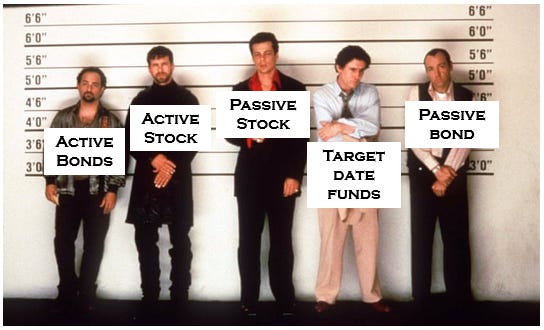📈 Let's Get Real
Look through any 401(k) plan and you’re likely to find a line-up of the usual suspects: a handful of target-date funds, a bunch of passive funds, maybe even a few active managers sprinkled in there. While it’s nice to have options, most 401(k) plans limit your investment scope to stocks and bonds (often by design).
On the one hand, that’s good. We recommend that most readers do everything they can to pump as much of their paycheck into their 401(k) and invest those savings aggressively. Whatever you may think of the direction of interest rates, current equity valuations, or demographic trends, the combination of stocks and bonds has worked just fine over the last forty years or so, thank ya very much:
However, what that means is that your 401(k) will naturally be overweight these financial assets. Financial assets aren’t physical things and derive their value from supply and demand in the marketplace they transact. So, if the stock market doesn’t think your stock is worth anything anymore, you got a problem.
Something that actually happens all the time:
Now, investing in broad-based indexes removes a lot of the risk of this happening. That’s because you’ll own a fraction of your assets in the floundering stock so the risk tends to be contained. In other words, if one stock is getting killed, there are 499 others to help cover the loss.
The problem with broad-based indexes is that if the sh*t really hits the fan, all the stocks or bonds in there tend to go down together. When COVID shook the markets back in March 2020, it pretty much didn’t matter what you owned, it lost money. Similar story for 2008, 2002, 1991, etc.
Fortunately, you can use non-financial assets to diversify your financial assets. Non-financial assets are the opposite of financial assets: most of their value derives from their physical traits.
If that’s confusing, think about real estate. Let’s say you’re looking for a 2-bed 1-bath apartment. The apartment in the ‘good’ part of town will cost more than the same apartment in the ‘bad’ part of town. Demand for apartments in the good part of town should be higher than the bad part of town, therefore justifying higher rent.
Now, imagine that you’re collecting the rent rather than paying it. The value of non-financial assets lies in their physical traits - in this case, location. And you can invest in that!
Non-financial assets is a really broad category of investments that includes real assets like real estate, gold, and commodities, as well as things like intellectual property, commercial vehicles, etc.
There aren’t a lot of ETFs out there that take positions in intellectual property (to our knowledge - WisdomTree, where you at?), so let’s talk briefly about the three most-common non-financial investments: real estate, gold, and commodities.
All three have a positive expected return due to scarcity, which makes sense: there’s only so much land to build on, there’s only so much gold or bitcoin that can be mined, and there’s only so much oil and gas that can be extracted. Thus, as the resource grows scarcer, the value should go up over time.
You can invest in real assets in three ways:
Directly, by owning the thing yourself
Indirectly, by owning a piece of the thing, usually via a limited partnership agreement or a derivative like a futures contract
Fractionally, by owning shares in a company that directly owns the thing
We prefer direct wherever possible and reasonable as that’s where the greatest advantages tend to accrue in the form of capital appreciation and tax treatment. Worth noting, directly owning something also almost universally demands the most work from you. That water heater ain’t going to fix itself.
Indirect investments include things like private equity and hedge funds, investments normally reserved for those who meet certain income and net worth requirements. You can invest in these outside of your retirement assets, but we don’t recommend it until you’re maxing out your 401(k) and IRA contributions each year.
Which leaves us with fractional ownership. If that’s confusing, it’s just another way of talking about the publicly-traded companies that directly own the real asset. For instance, Starbucks is a multinational company with hundreds of thousands of employees and tens of thousands of retail locations, all of which depend on the availability of coffee beans. So, if you think coffee is going to continue to be popular in the future, then it probably makes sense to buy Starbucks.
While fractional ownership has some limitations, it does offer a way to access real assets without taking on the burden of direct ownership yourself or having to qualify with sufficient assets.
And, even if 401(k) doesn’t offer these investment options, your IRA sure does.
What’s the Upside?
Whether they mean to or not, a lot of people end up doubling down on stocks between their 401(k) and IRA assets. Which, normally, is fine, but ends up being problematic when the stock market inevitably slams on the brakes every five to ten years, creating similar losses in both retirement accounts.
Use the far broader investment choices offered by your IRA to mix some non-financial assets into your total portfolio. That way, you’re mixing a bet on the direction of stocks and bonds alongside a bet on the continued scarcity of real estate, gold, or commodities.
For Your Weekend
Read:
The Company Man by Stephen Marche (Toronto Life)
Tse Chi Lop doesn’t look like the biggest drug lord in history. He looks like a bedraggled, exhausted, late-middle-aged trader in commodities, which is exactly what he is. Tse’s commodities just happen to be high-margin, addictive, illegal drugs—heroin, ketamine and methamphetamine. Tse runs a drug syndicate known to law enforcement as “Sam Gor,” Cantonese for “Third Brother,” and to its members simply as the Company. The United Nations Office on Drugs and Crime estimates that Sam Gor’s annual revenue could be as high as $21 billion, the same as Citibank’s.
The Best Performances of 2021 by The Ringer Staff (The Ringer)
From dramatic turns in cinema to sharp-witted television humor—plus a few unorthodox picks in between—these were the year’s best entertainers














